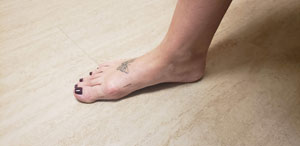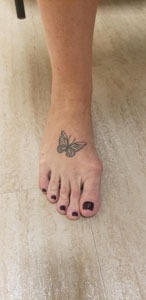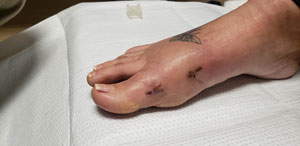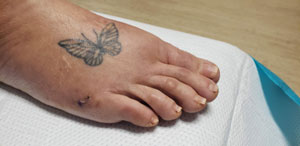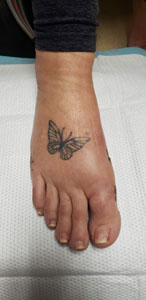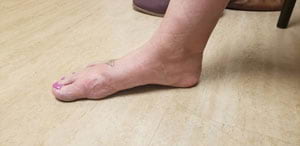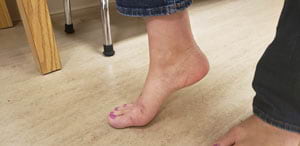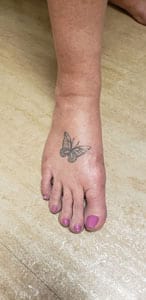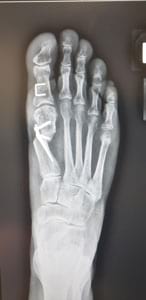Bunion Surgery- Case Study
2 month post-op minimally invasive bunion video of patient walking bare foot without pain or a limp
Before Surgery
Between the PreOp and After Surgery
After Surgery
Atlantic Orthopaedic Specialists Surgeon Michael A. Campbell Brings Significant Advance for Minimally Invasive Foot and Ankle Surgery to the Region
A revolutionary new device allows many foot and ankle surgeries to be done through a ¼ inch incision.
Old fashioned bunion surgery has a bad reputation for being painful and unreliable – big ugly incisions, long recoveries, crutches, casts, and weekly doctor visits. The latest technology in bunion surgery has radically changed all of this, most notably the need for long incisions and the resulting scars on the foot!
Until recently, open surgery has been required to correct bunions, bone spurs, flat feet, fallen arches, big toe arthritis and multiple other painful foot conditions. Now a new surgical tool, FDA approved in the spring of 2017, is available in the United States. Dr. Michael A. Campbell, an Orthopaedic Foot and Ankle Surgeon with Atlantic Orthopaedic Specialists, is the first in Hampton Roads trained to use this device. He is bringing minimally invasive surgery (MIS) for several common, painful foot conditions to the area.
“This is a revolution in how foot and ankle surgery can be performed; I equate this advancement to what the Jiffy Hip did to change hip surgery,” said Dr. Campbell. “It’s remarkable.”
Dr. Campbell explained that minimally invasive surgery offers significant advantages in many types of surgery for the foot and ankle. The PROStep, manufactured by Wright Medical, is a specially designed surgical instrument that allows surgeons to cut through or trim off boney structures without damaging the surrounding soft tissue. This is all done through very small incisions, approximately 2-3 millimeters – less than ¼ of an inch! Smaller incisions reduce the risk of post-surgical infection, pain, scars and the time it takes patients to heal skin incisions.
“This new technology is a game changer. It is possibly the most exciting advancement I have seen in foot and ankle surgery in my career. I made it a priority to be among the first surgeons nationally to be trained on the PROStep,” said Dr. Campbell. “I wanted to make it available to patients in this area.”
Recently, Megan Shinn with WVEC TV interviewed Dr. Campbell to discuss the device and its applications in foot and ankle surgery. Watch the video below to learn and see how this revolutionary technology works:
Source: www.atlanticortho.com
Arthritis impacted local athlete, synthetic cartilage saved the day
Arthritis impacted local athlete, synthetic cartilage saved the day
The patient is playing professional basketball in Europe since graduating as an all-american senior year from Christopher Newport University
VIRGINIA BEACH, Va., (WVEC) -- The CDC said arthritis impacts 54 million Americans, and the number is growing every year.
Most people assume arthritis happens to older people, but it's common in athletic people, too.
Aaron McFarland played basketball for Christopher Newport University. He was jersey number 1. His life was changed after one game last year.
“My right foot landed on the court. My left foot landed on the drop-off, and it jammed so hard, it tore the ligament in my left big toe,” said McFarland. “Well, I thought instantly that I broke my foot, and I thought it was over.”
His big toe got arthritis, so he went to Atlantic Orthopaedic Specialists, in Virginia Beach, for help.
“It’s not that big a problem until it’s your toe, and every single step you take hurts,” said Orthopedic foot and ankle surgeon Michael Campbell.
Campbell said he knew McFarland needed to get back on the court, and a 'fusion' is the typical surgery to get rid of the pain, but it limits mobility.
“This was sort of an unsolvable problem in orthopedics,” said Campbell. “Especially someone how liked to run and stuff. There weren’t any reliable treatment options we had that would maintain motion, and allow them to do the activities they wanted without pain.”
So, he implanted Cartiva, a synthetic cartilage in the basketball player’s toe. It’s an FDA approved implant made of contact lens material.
“To my knowledge, what it seems like the first high-level athlete that had this done on them,” said Cambell.
The same day of the fifteen-minute surgery, McFarland was walking again. After a whole year playing with the hurt toe, McFarland got back up to speed in two months.
“I felt like I had a whole new foot and I was just ready to go,” Mcfarland said.
During his senior year, McFarland not only healed, but he became an All-American basketball player.
Studies show the synthetic cartilage lasts more than 10 years. So far, McFarland's shows no sign of wearing down.
Campbell said the Cartiva implant costs about $2,500, but most insurance companies cover the cost.
Source: www.13newsnow.com
Groundbreaking and life changing surgery happening in Hampton Roads
Groundbreaking surgery changes a local woman's life and could have a big impact in the Hampton Roads medical community.
HAMPTON ROADS, Va. (WVEC) -- For most of her life, 37-year-old Natashia Christian has had to live with bowed legs. It's a condition that comes along with her genetic form of Vitamin D resistant rickets. Her son also has the condition.
While surgeries are working for him, Natashia hasn't had much luck. That is until she met Dr. Michael Campbell with Atlantic Orthopedic Specialists a year and a half ago. He knew there was a new procedure that could help her.
The hexapod external fixator had just gained FDA approval. While it had been used in other countries to correct bone deformity, Dr. Campbell is the first U.S. doctor to use the Hexapod on the upper and lower leg together.
He says this procedure is groundbreaking because "it's an exceptionally powerful tool and sometimes it gives you the opportunity to fix problems and correct deformities that otherwise would have been challenging or impossible."
Dr. Campbell did the first surgery on Natashia last year to straighten her right leg. Almost one year to the day she was wheeled into the operating room at Sentara Leigh Hospital to straighten her left leg. This time, he only had to use the fixator on the lower part of her leg. That's because she's already has a rod in her femur.
We caught up with Natashia almost three months post surgery. While she was still wearing the fixator she said she was already amazed at the difference she could see.
She said, "I just keep looking at it cause all my life I had bowed legs and no matter what the doctors did to try and straighten it just tended to bow right back out. Now it's like it feels like it's going to stay."
Dr. Campbell says the bones should stay in place. The fixator actually helped to align Natashia's legs properly and allowed her to grow bone to fill in where needed. That made Natashia three inches taller and more importantly, Dr. Campbell says for the first time her legs are actually straight.
He says, "It's one of these times when you really see the difference. I have this video of her walking before the first time we met on the first office visit and now when you look at her legs and you see how straight they are I know that it means that her knees, her hips her ankles and her femurs and stuff like that are going to last longer and work better."
Source: www.13newsnow.com



